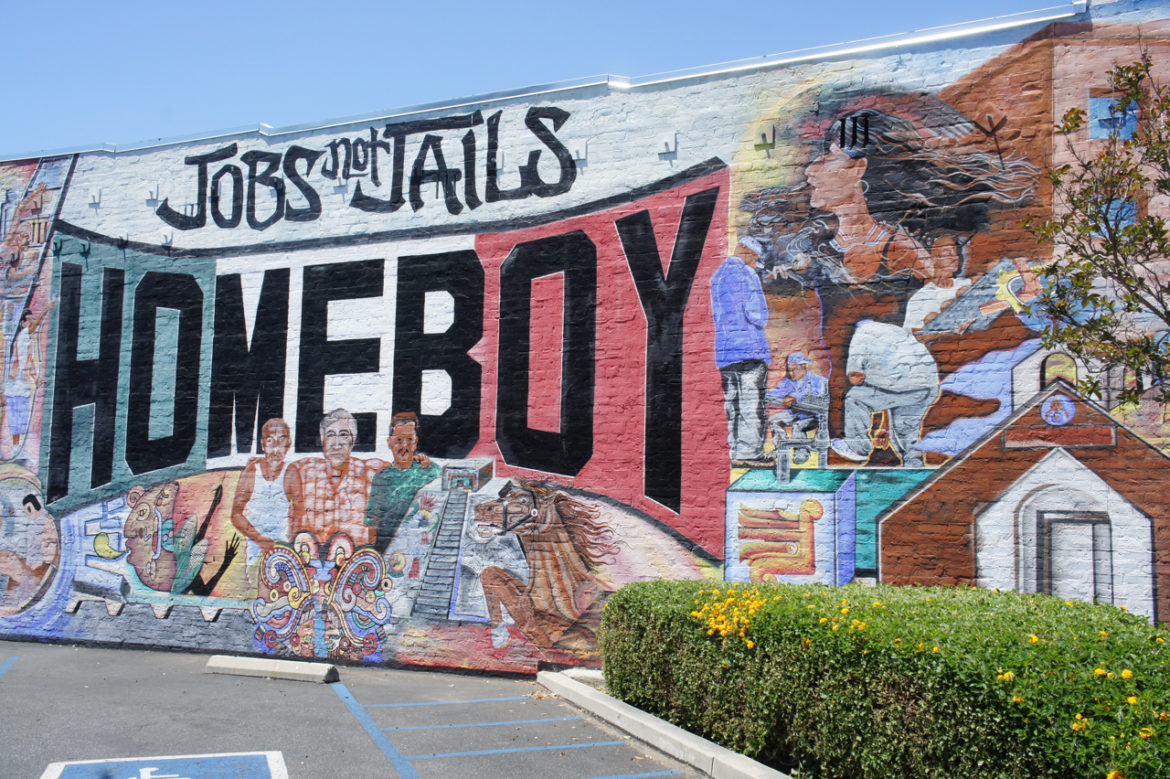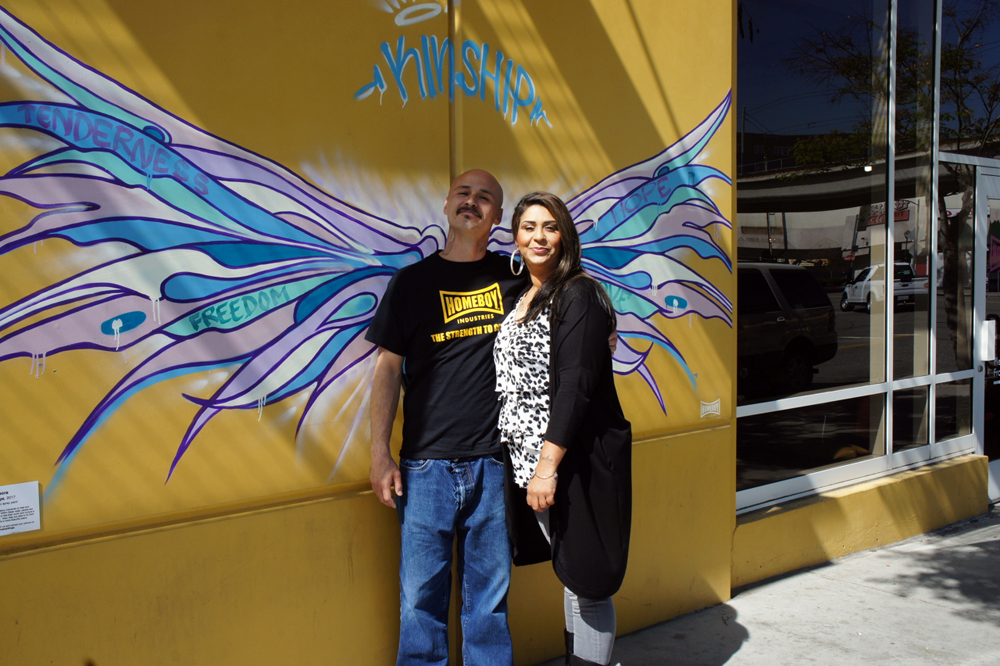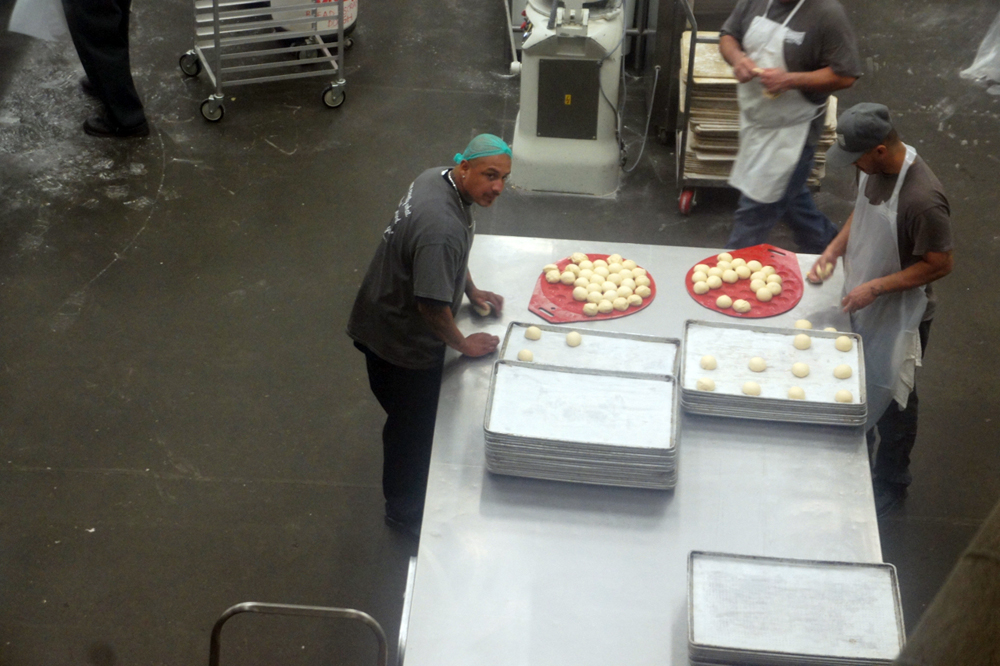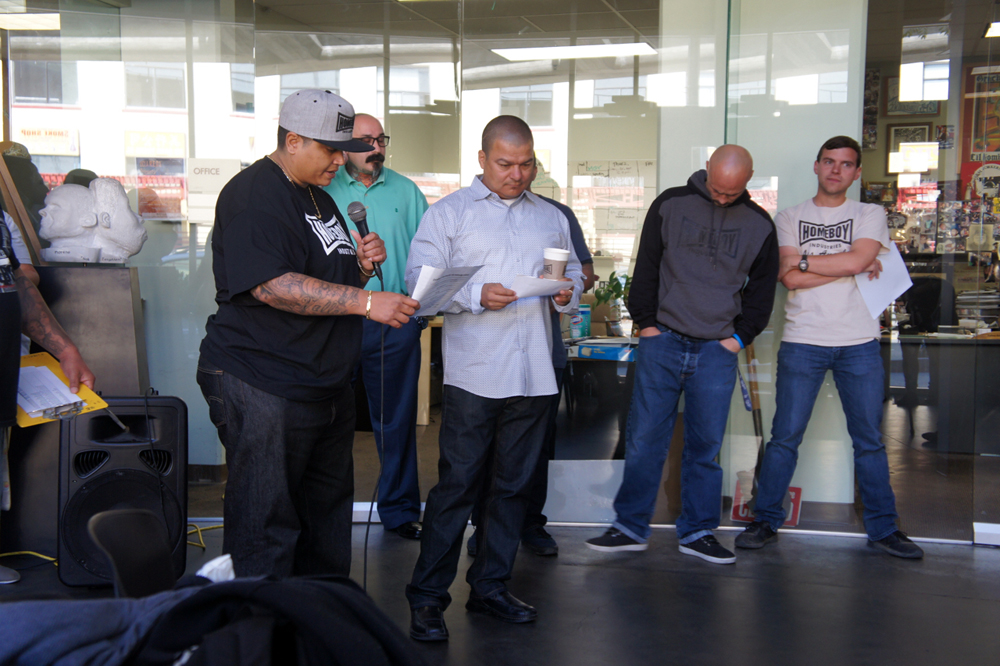
Photos by Stell Simonton
The original location of Homeboy Industries in Los Angeles is now a charter school operated by Homeboy and Learning Works for youth who are coming out of juvenile detention or have dropped out of school.
LOS ANGELES — Garry Powers stands on Alameda Street near the North Vignes Street overpass, across from a smoke shop and a Vietnamese restaurant. He’s on the edge of Chinatown and a couple of miles north of Boyle Heights, a neighborhood once rife with gangs.
The wall behind him is a glowing yellow-gold. Painted on it are outspread blue wings that nearly match the faded tattoo on his neck. He looks swathed in wings. A halo on the wall seems to hover above his head.
Powers grew up in Baldwin Park outside Los Angeles. A member of the Desmadre gang, he was arrested for armed robbery, assault and carrying a concealed weapon and spent most of his teen years in juvenile detention. He spent his 20s in prison for carjacking.
“As a adolescent, I made a lot of poor choices from being in a gang,” he said.
For more information on Re-entry, go to JJIE Resource Hub | Re-entry
Now age 37, he’s giving a tour of Homeboy Industries, a large building with an industrial bakery, a cafe, offices and a merchandise shop. It’s a Los Angeles gang intervention, rehab and reentry program that also advises other programs around the country.
“We understand you can’t force nobody to change,” Powers said as he stands in front of the mural. But Homeboy Industries offers kinship, freedom, hope and love, he said.
It’s there to give support and training to young men and women who have been in gangs or have been incarcerated.
Currently 220 people, called trainees, are in its 18-month program. Most are male; 30 percent are women.
Powers, a trainee, has been clean and sober for 10 months. What’s keeping him there?
“The motivations are my children,” he said.
Homeboy was started by Jesuit priest Greg Boyle, who came to Dolores Mission Church in 1984 when it was one of the poorest and most gang-ridden parishes in Los Angeles. The city had so much gang violence, it was sometimes called the gang capital of the world.
He quickly came to the conclusion that “nothing stops a bullet like a job.” In 1988, he and the congregation asked community businesses to hire gang members, and he arranged for funds to be donated to pay their wages.
Initially called Jobs for the Future, the initiative started its own businesses to employ former gang members, beginning with Homeboy Bakery in 1992. Today its enterprises include the Homegirl Cafe, a City Hall diner, solar panel installation, electronics recycling and a silkscreen and embroidery business. In them, former gang rivals can be found working side by side.

Outside Homeboy Industries in Los Angeles, Garry Powers stands with Nicole Cordero, another trainee. The organization provides jobs and rehabilitative services to those who have been incarcerated or in gangs.
Hustle and bustle
“Everyone starts [working] in maintenance,” Powers said. And sure enough, the building is clean, with numerous young men pushing rolling bins and carrying mops.
In fact, it’s a bustling place with a circular reception desk staffed by several young men who sit, jump up and ask passers-by if they need help. Behind the desk are three glass-walled offices, with people clustering outside each one.
Chief Trainee Director Hector Verdugo steps out of his office intermittently, offers a hearty greeting and ushers in employees and visitors for short meetings. Father Greg, as he is called, is out of town this day on one of the numerous speaking engagements that raise cash for the organization.
Rows of chairs near the reception desk serve as a waiting area. Although a TV screen is mounted high on the wall, nobody bothers to watch it. There’s too much activity on the floor.
People step in from the Homegirl Cafe, just off the lobby, which offers drinks like Paulina’s Latte and Angela’s Green Potion (spinach and mint limeade) along with brunch dishes, sandwiches and tacos.
Every few minutes the front door opens and people of all ages enter — a woman with two children, a young man alone, an older woman.
And the young men with rolling bins pass through, greeting the people they know.
Homeboy Industries is like a busy community center. In addition to its employees and trainees, about 1,000 members of the community come to the building each month for free classes and services such as tattoo removal.

Homeboy Industries Bakery in Los Angeles, which produces pastries, bread and specialty goods, provides training and jobs to former gang members.
‘We’re showing up’
Around 9 a.m., the activity stops for a brief morning meeting of everyone there.
Verdugo offers a thought for the day. Even when he wakes up on the wrong side of the bed, feels bad and thinks about hustling with his old friends, he reminds himself to be positive.
“I say to myself: ‘Smile.’ It’s the medicine I need to take every day.”
Another man stands up: “My brother just died,” he said. He puts out a donation box for people to contribute to funeral expenses.
A woman offers a prayer: “Dear Awesome God, today is Monday. We’re showing up. We’re suited up … We’re coming as a community.”
After the meeting, Powers explains the program.
“We’re paying you to be in recovery,” he said. Trainees take a course called Homeboy 101 that orients them. They receive $11 an hour, rotating jobs every six weeks.
Each is assigned a case manager, therapist and a “navigator,” who serves as a guide and mentor.
The case manager creates a plan — sometimes court mandated — that may include classes and support groups.
Almost 40 classes are offered each week for trainees and community members. They cover anger management, parenting and building positive relationships, as well as meditation, yoga and music. Court-approved domestic violence classes are offered. Support groups include Alcoholics Anonymous, Narcotics Anonymous and Criminals and Gang Members Anonymous.
Trainees should take at least three classes per week, Powers said. He himself relishes being a student. His favorite is the parenting class. With a son and four young daughters, the class was immediately useful, he said. He also really like the class Writing Your Story.
“There’s a lot of trauma that’s happened in our lives” and writing can help, he said.
About 30 therapists, mostly volunteers, provide counseling to trainees and employees. “Everyone can see a therapist once a week,” Powers said.
Navigators are former gang members, most of whom have gone through the Homeboy Industries program.
One navigator, Kusema Thomas, was in the 43GC gang in South Central Los Angeles. When members leave the gang life behind they “have a big pile of stuff to deal with,” he said.
“They get angry and they don’t know what to do.”
The navigators show by example another way of being. In order to change, Thomas said, you have to mentally think about the person you want to become.

Hector Verdugo (holding coffee cup) takes part in a morning meeting in the lobby of Homeboy Industries. He is chief trainee director at the nonprofit organization.
Tattoos and hearts
Upstairs near the classroom area, a hallway is lined with people. They’re waiting outside an office where two doctors use lasers to break tattoos into tiny ink particles. Repeat sessions are necessary to remove the tattoos.
“It hurts really bad,” Powers said, but each session is short. The 35 doctors who remove tattoos are volunteers, he said.
Outside on the street is a mobile medical clinic. Homeboy Industries sees value in being a “one-stop shop,” Powers said.
A small book and merchandise shop opens onto the street. Pam Herrera sits behind a desk ringing up sales. She got out of prison seven years ago when she was in her mid-20s. Never an official gang member, she was nevertheless affiliated through her boyfriend. She had problems with drugs and ended up on the street, she said.
After her release from prison, she took part in a sober living program at Walden House Health Right 360, then started as a hostess in the Homegirl Cafe. She eventually became assistant manager.
In addition to providing training and work, Homeboy provides the space so “you can focus on yourself,” she said. Coming out of prison, you’re ashamed and broken and “you don’t want to be judged,” she said.
Father Greg’s books are on display in the center of the shop. His 2010 book “Tattoos on the Heart: The Power of Boundless Compassion” tells stories of young gang members and the impact of acknowledgment and love. “Barking to the Choir: The Power of Radical Kinship,” published in 2017, explains what he has learned in three decades of working with them. Los Angeles author and journalist Celeste Fremon also describes his early work in the neighborhood in the book “G-Dog and the Homeboys.”
It takes more than a job to stop a bullet
At one time, Boyle considered jobs the primary solution to gang involvement.
He has changed philosophically, said Alison Lass, Homeboy spokesperson and manager of the Global Homeboy Network, which provides advice to organizations around the country.
Young people who join a gang are often fleeing a home with drug addiction, abuse, instability or mental illness, she said. Poverty, poor housing and unsafe streets are contributing factors, she said.
“There’s an addictive cycle to being a gang member,” Lass said. It’s a revolving door of violence and incarceration. “And a lot of them become addicted [to drugs] in response to trauma,” she said.
Homeboy Industries now has a “fellowship model” in which comprehensive services are integrated with its social enterprises, she said. “The experience helps people process their trauma. Without that healing, a job isn’t going to stop the cycle.”
Homeboy Industries funds its work through individual, foundation and corporate donations and through its businesses, which provide slightly less than one-third of its $18.5 million revenue, according to the 2017 annual report.
Some lose money because they are staffed with two to three times the number of workers a business would need, said chief financial officer Jack Faherty. Government agencies provide only about 11 percent of revenue, according to the annual report.
Multiple chances to change
A man sits in the reception area tapping his foot nervously. He declines to give his name, but said he’s 23. He got out of prison three weeks ago.
He knows all about Homeboy Industries. He remembers meeting Greg Boyle when he was 15 and in juvenile detention.
“I still have his number,” he said.
His recent prison conviction was for criminal threat and assault, but he’s here for a second or third … or more … chance.
“I know that the doors here are never closed. If you aren’t ready, come back when you are,” he said.
He has a 4-year-old son and doesn’t want a life of violence and incarceration for his child.
“I plan on learning how to bake,” he said.
In many ways, Homeboy Industries functions as a beloved community. Powers describes it as “a safe place, a sanctuary, a refuge.”
When Powers stands in front of the angel mural, painted by a friend and former gang member, the message is manifest. At Homeboy Industries, he is loved.